Strawberry Matcha Latte is one of the most visually striking and flavorful drinks trending today. Known for its bold contrast of vibrant green matcha, rich strawberry puree, and creamy milk layers, this eye-catching beverage has become a favorite across coffee shops, social media, and home kitchens alike. Its sweet-meets-earthy flavor profile makes it stand out from traditional matcha drinks, offering something new for latte lovers and matcha fans to enjoy.
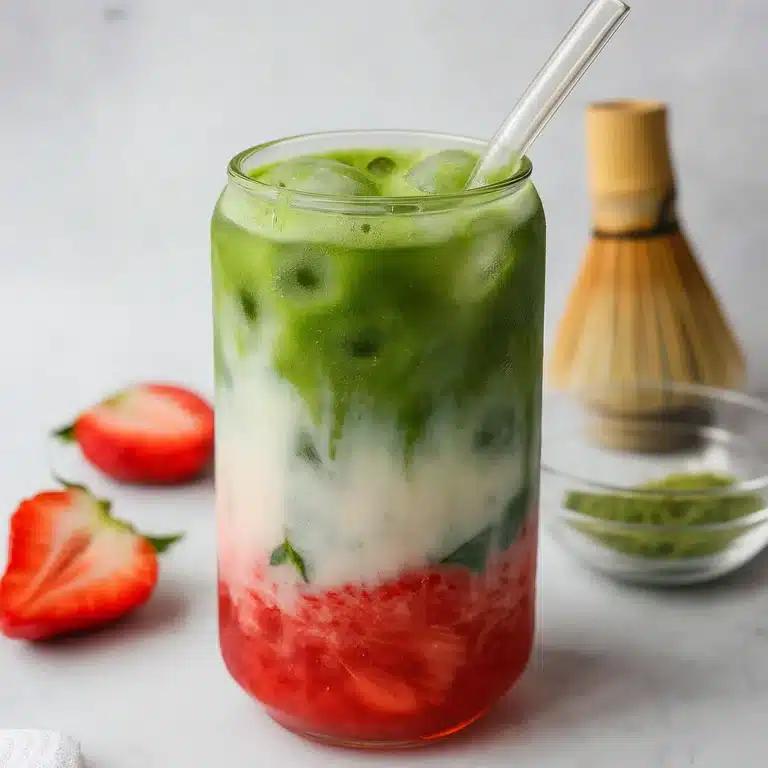
Now, we’ll dive deep into what makes the strawberry matcha latte so appealing, how strawberries and matcha work together in recipes, and why this drink is dominating modern café menus. You’ll also learn how to make it yourself, explore flavor variations, and get answers to the most common questions about mixing ingredients like matcha and fruit.
Table of Contents
Introduction to Strawberry Matcha Latte
What is a Strawberry Matcha Latte?
This popular drink blends sweet strawberry puree, creamy milk, and vibrant matcha tea into a visually layered beverage. Served mostly iced, it features distinct red, white, and green layers that are both beautiful and flavorful. The fruity base complements the slightly bitter green tea, offering a unique twist on traditional café drinks. It’s especially favored for its bold contrast in taste and look, making it a creative alternative to standard lattes.
Why It’s Trendy: Flavor Meets Aesthetic
Rising to fame through social media, this drink has become a favorite for its visual impact and refreshing taste. Whether it’s prepared at home or ordered from a trendy coffee shop, it offers an experience that’s equal parts flavor and presentation. Its appeal goes beyond taste—people love how customizable it is, from the choice of milk to how it’s served. The mix of fruit and tea in one glass has quickly become a standout option among modern drink trends.
If you’re a fan of matcha, try pairing your latte with our no-bake matcha cookies—a simple and delicious way to enjoy that bold matcha flavor in dessert form too.
Benefits of Drinking Strawberry Matcha Latte
Layered Flavor That Stands Out
One of the biggest perks of sipping a strawberry matcha latte is its complex yet balanced flavor. It starts with the fruity sweetness of strawberries, followed by the creamy middle layer of milk, and finishes with the bold, grassy notes of matcha. This combination hits multiple taste zones—sweet, earthy, and creamy—offering a drink that’s rich and refreshing at the same time.
Unlike plain lattes or fruit teas, this fusion keeps your palate engaged. Each sip delivers a slightly different ratio of fruit, milk, and matcha, depending on how it’s stirred or layered. It’s a multi-sensory experience where you can actually taste the flavor evolving as you sip.
Aesthetic and Instagram-Worthy Appeal
The strawberry matcha latte isn’t just delicious—it’s also a visual masterpiece. With bold green matcha floating above strawberry red, separated by a layer of milky white, this drink has become a favorite subject for photos and reels. It’s no surprise that its popularity exploded on TikTok and Instagram.
Whether you’re a content creator or just love sharing café moments, this drink makes your feed pop. And because it’s so customizable, every glass can look slightly different—making each creation feel personal and unique.
Its presentation is right in line with other creative beverages that play with color and contrast—like the vibrant coconut and pineapple mocktail, which also turns simple ingredients into a stunning layered drink.
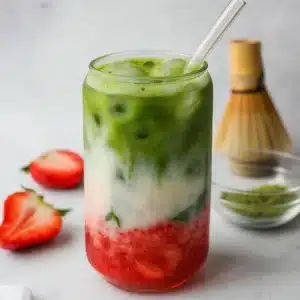
Strawberry Matcha Latte
Equipment
- 1 electric frother
- 1 Tall glass
- 1 Strainer
- 1 Spoon for layering
Ingredients
- 1 tbsp matcha powder
- 2 oz warm water (160–175°F)
- 1/4 cup strawberry puree (fresh or store-bought)
- 3/4 cup milk (dairy or plant-based)
- Ice cubes, as needed
- sweetener (optional — honey, agave, or syrup)
Instructions
- Sift matcha powder into a bowl.
- Add warm water and whisk until frothy.
- Pour strawberry puree into the bottom of a tall glass.
- Gently drizzle the milk down the back of a spoon to keep the layers separate.
- Add ice cubes to keep the layers separate.
- Gently top with whisked matcha.
- Serve as-is or stir gently before drinking.
Notes
Nutrition
Does Strawberry Go Well with Matcha?
Taste Harmony: Sweet Meets Earthy
The flavor of a Strawberry Matcha Latte comes from a contrast that just works—fresh strawberry adds fruity sweetness, while matcha green tea brings depth and a subtle earthiness. This pairing may seem unexpected at first, but it’s quickly become a favorite among those who enjoy creative drink combos. Each sip offers something different depending on how the layers blend together, delivering a smooth yet bold taste.
What makes this latte shine is the natural sugar in strawberries mellowing out matcha’s bitterness. When served iced, the cold temperature enhances the drink’s balance, making it feel more refreshing. For people who find plain matcha too strong, adding strawberry can be the perfect introduction.
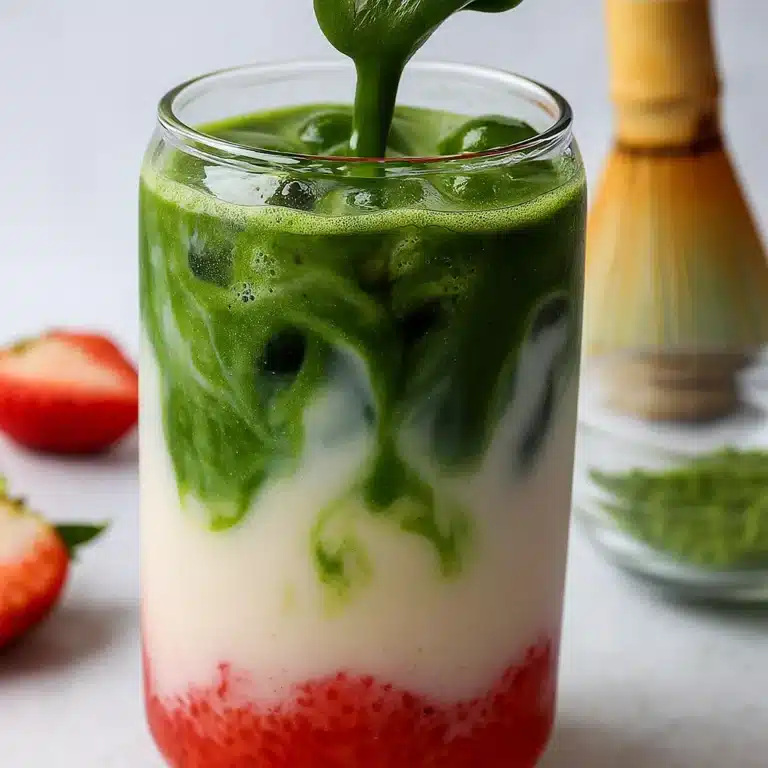
Popular Recipes That Highlight the Pairing
Several versions of the Strawberry Matcha Latte have gained traction, especially on café menus and social media platforms. From classic iced lattes with distinct layers to blended drinks where the ingredients are mixed into one vibrant hue, the possibilities are endless.
For a twist, add strawberry syrup to sweeten things up or use coconut milk if you’re going for a tropical vibe.
Others incorporate vanilla or almond extract for added aroma. Regardless of how it’s made, the drink remains a standout choice for anyone looking for something flavorful and visually appealing.
This layered approach to flavor and texture is also what makes other drinks—like our brown sugar in coffee twist—so compelling. In both cases, balancing bitter with sweet leads to a drink that feels crafted, not just mixed.
What You Shouldn’t Mix with Matcha
Ingredients That Clash with the Strawberry Matcha Latte Experience
Not every ingredient pairs well with matcha, especially when strawberries are involved. For example, spicy flavors like cinnamon or overly bold herbs can disrupt the smoothness of a Strawberry Matcha Latte. Likewise, sour fruits—such as grapefruit or lemon—can overpower the strawberry-milk-matcha blend, making the final result taste off.
Another thing to avoid? Heavy artificial sweeteners or thick caramel sauces. These tend to mask the light flavors in the drink and create an unbalanced taste. To preserve the unique profile of your latte, it’s best to keep things simple and let the ingredients speak for themselves.
How to Avoid Common Preparation Mistakes
Creating a smooth and flavorful Strawberry Matcha Latte isn’t just about picking the right ingredients—it’s also about proper technique. One common mistake is using boiling water to dissolve the matcha. Doing this might burn the powder and leave behind a harsh, unpleasant flavor. Instead, use warm (not hot) water, and whisk thoroughly until frothy.
Also, always sift your matcha powder before preparing the drink. This prevents clumps and ensures even mixing. If you’re layering the drink, be careful not to stir too aggressively—keeping the layers intact is part of the fun and flavor journey.
If you’re drawn to unique combinations, our no-bake praline pecan cookies demonstrate how balancing flavors can elevate even the simplest recipes.
Potential Disadvantages of Drinking Matcha Every Day
Caffeine Sensitivity and Taste Fatigue
While sipping a Strawberry Matcha Latte can be a delicious daily ritual, it’s worth noting that matcha contains caffeine—though typically less than coffee. If you’re someone who’s sensitive to caffeine, having this drink every day might lead to restlessness or affect your sleep. That’s especially true if you’re also consuming other caffeinated products throughout the day.
Beyond just the caffeine boost, having the same drink every day can dull your sense of flavor over time.
Because the flavor of matcha is strong and distinct, drinking it too frequently might dull your enjoyment of the drink over time. The strawberry element helps balance the flavor, but if you’re not rotating your beverages, it could eventually feel repetitive.
Overdoing It with Add-Ons and Sweeteners
One of the best things about a Strawberry Matcha Latte is how customizable it is. Still, having too many options can backfire if you’re not paying attention. Adding too much syrup, sweetened condensed milk, or flavored powders can make the drink overly sweet or heavy. This can overshadow the unique balance that makes this latte so popular in the first place.
Also, using low-quality matcha in an effort to cut costs can result in a bitter aftertaste or muddy color. If you’re planning to make this latte part of your regular drink routine, it’s worth investing in a good matcha powder and keeping the other ingredients in check.
If you’re someone who likes experimenting in the kitchen, you might find similar satisfaction in our date brownie balls. They’re naturally sweetened and offer that same mix of indulgence and moderation—just in snack form.
What Fruits Complement Matcha?
Best Pairings: Strawberry, Citrus, and Berries
When it comes to pairing fruit with matcha, some stand out more than others. Strawberry Matcha Latte has become a fan favorite because strawberries offer just the right level of sweetness and acidity to balance matcha’s earthy tone. But other fruits also complement green tea beautifully. Blueberries, raspberries, and blackberries all bring a subtle tartness that enhances the drink without overpowering it.
Citrus fruits, especially orange and yuzu, work well in small amounts—especially in teas and chilled beverages. Their zesty notes brighten the matcha, though in the context of a creamy latte, they’re best used lightly or as a garnish.
Flavor Balancing: Sweet vs. Tart Choices
When crafting a custom version of a Strawberry Matcha Latte or a similar drink, balance is everything. Sweet fruits like mango or pear can mellow the bitterness of matcha, while tart ones like kiwi and pineapple add a refreshing bite. However, these should be used with intention. Too much tartness can clash with the creamy base, while overly sweet fruits may mask the subtle tones of matcha.
The key is to experiment while respecting matcha’s flavor strength. That same flavor balancing principle makes its way into creative treats like our lemon oatmeal no-bake cookies, which pair tangy citrus with comforting textures—a similar contrast to matcha and fruit.
How to Make the Perfect Strawberry Matcha Latte at Home
Ingredients Checklist
Making your own Strawberry Matcha Latte at home is easier than it looks—and it gives you full control over taste and sweetness. Here’s what you’ll need:
| Ingredient | Quantity | Notes |
|---|---|---|
| Matcha powder | 1 tsp | Ceremonial grade for best flavor |
| Warm water | 2 oz | Not boiling—around 160–175°F |
| Strawberry puree | 1/4 to 1/3 cup | Fresh or store-bought |
| Milk (any kind) | 3/4 cup | Dairy or plant-based |
| Ice cubes | As needed | Keeps layers distinct |
| Sweetener (optional) | To taste | Honey, agave, or simple syrup |
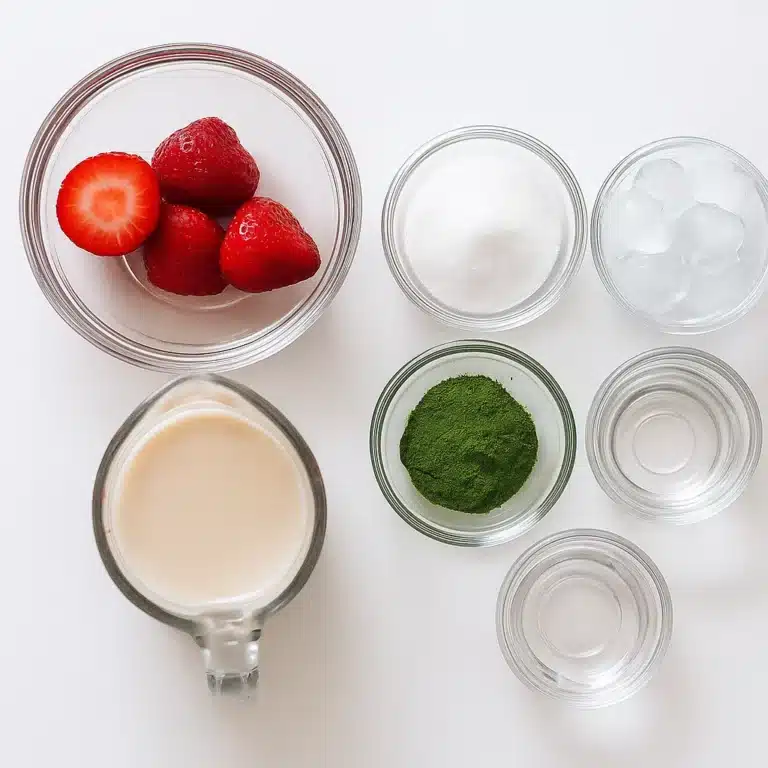
Optional add-ins include vanilla extract or a pinch of salt to bring out flavors.
Step-by-Step Brewing and Blending
- Prepare the Matcha: Start by sifting one teaspoon of matcha powder into a bowl to break up any clumps before mixing. Pour in warm—not hot—water, then whisk briskly back and forth until the texture becomes smooth and light.
- Spoon your strawberry purée into the base of a tall serving glass to form the first layer. Feel free to modify the amount depending on how strong you’d like the strawberry flavor.
- Add Milk: Slowly pour the milk over the back of a spoon to avoid disturbing the strawberry layer too much. Drop in several ice cubes—not only for a refreshing chill, but also because they act as a barrier that helps the liquids remain separate.
- Gently stream the whisked matcha into the glass over the milk, aiming for a slow, steady pour to preserve the separation between layers. Using the back of a spoon to guide the pour can make it easier to keep each layer distinct and visually appealing.
- Serve and Stir (or Don’t): Serve immediately. Some people like to mix it all together for a unified flavor, while others prefer sipping through each layer for a more dynamic experience.
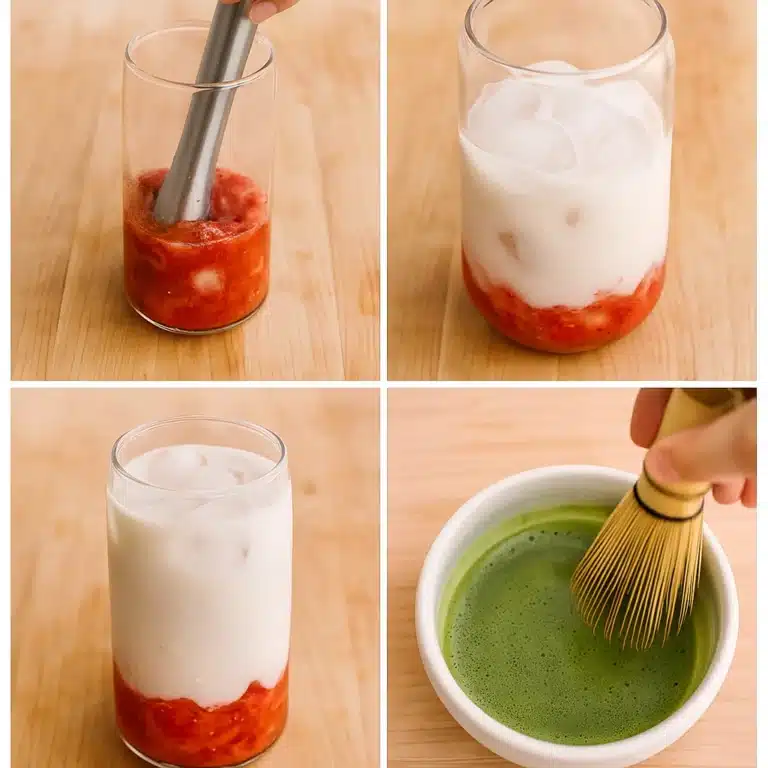
This method isn’t just easy—it’s a visually satisfying process that rivals any café creation. For another quick, chilled treat with a bit of indulgence, try our cookie dough bark, which also uses minimal ingredients and no baking.
Variations & Customization Tips
Hot vs. Iced vs. Frappé Versions
The classic Strawberry Matcha Latte is often served cold, but there’s no reason to stop there. If you prefer something cozier, try a hot version. Simply warm your milk and strawberry puree, then gently whisk in prepared matcha. The flavors become slightly more blended and mellow, giving you a comfort drink that still looks stunning.
For warmer weather or extra indulgence, turn your latte into a frappé. Blend ice with the strawberry and milk layers, then top with whipped matcha for a frosty treat. This version is popular in cafés and makes a great base for toppings like whipped cream, dried strawberries, or matcha dust.
Dairy & Plant-Based Milk Options
One of the best parts of crafting a Strawberry Matcha Latte is how flexible it is with milk choices. Here’s a quick look at how different types of milk change the texture and taste of your drink:
| Milk Type | Flavor Profile | Texture |
|---|---|---|
| Whole milk | Creamy, rich | Thick and smooth |
| Oat milk | Slightly sweet, nutty | Creamy and frothy |
| Almond milk | Light and nutty | Thinner texture |
| Coconut milk | Tropical, slightly sweet | Thick, bold flavor |
| Soy milk | Neutral, subtle sweetness | Smooth and dense |
Choosing your milk affects not just taste but how well the layers hold up, so don’t hesitate to experiment. You can even add a dash of vanilla or rose water to create a twist on your traditional strawberry matcha latte.
FAQs
Is strawberry and matcha a happy marriage?
Yes, strawberries pair surprisingly well with matcha. The sweetness and slight tartness of strawberries balance the earthy, umami-rich flavor of green tea. This contrast enhances the overall taste, making a Strawberry Matcha Latte smooth, refreshing, and easy to enjoy, even for those new to matcha drinks.
What should you not mix with matcha?
While matcha is versatile, there are ingredients that don’t work well with it—especially in a Strawberry Matcha Latte. Steer clear of sharp citrus fruits like lemon or grapefruit, as they tend to overpower matcha’s subtle taste. Strong spices such as cinnamon or clove can also overpower the delicate matcha profile. Stick to soft, complementary flavors like berries, vanilla, or neutral dairy or plant-based milks.
Is there a downside to having matcha on a daily basis?
Drinking matcha daily is generally fine for most people, but overconsumption might lead to caffeine-related effects such as jitteriness or disrupted sleep. Since Strawberry Matcha Lattes often include other ingredients like sugar or flavored milk, daily intake may also increase calorie and sugar consumption if not moderated.
Any other fruit that compliments matcha?
Aside from strawberries, matcha pairs well with fruits like blueberries, raspberries, mango, and even banana. These choices bring gentle sweetness and help soften the sharp edge of matcha. In lattes, strawberries remain a top choice because of their smooth blend with creamy textures and green tea’s bold notes.
Conclusion: Why Strawberry Matcha Latte Deserves a Spot in Your Drink Rotation
The Strawberry Matcha Latte isn’t just a fleeting trend—it’s a drink that perfectly blends visual appeal with bold, balanced flavor. Whether you enjoy it for its colorful layers, its sweet and earthy pairing, or the satisfaction of crafting it yourself, it’s a standout choice for any season. From iced to blended to hot variations, this latte offers endless room for personalization.
As this drink continues to show up across café menus and creative home recipes, it’s also gaining traction in online communities. You’ll often see new twists and presentation ideas shared on platforms like Pinterest, X, and Facebook, where its layered look and vibrant colors have found a natural home.

